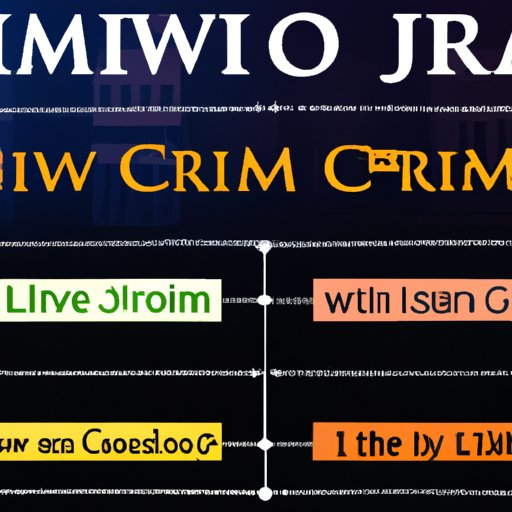Introduction
The term “Jim Crow” is often used to refer to the laws that enforced racial segregation in the United States. But what are Jim Crow laws? Where did they come from? This article will explore the origins and impact of Jim Crow laws in the United States, tracing the timeline of their development and analyzing how they perpetuated discrimination.

An Overview of Jim Crow Laws and Their Origins
Jim Crow laws were a set of state and local statutes that mandated racial segregation in public places and denied African Americans equal access to public facilities, services, and goods. These laws were based on the principle of “separate but equal,” which was upheld by the Supreme Court in the 1896 case Plessy v. Ferguson. The name “Jim Crow” is believed to have originated from an early 19th century minstrel show character named “Jim Crow,” who was portrayed as a clumsy, dim-witted African American man.
The History of Jim Crow Laws in the United States
Jim Crow laws were most prevalent in the Southern states during the late 19th and early 20th centuries. However, the roots of these laws can be traced back to before the Civil War. During this period, some Northern states had enacted laws that restricted the rights of African Americans, such as requiring them to post bonds in order to vote or prohibiting interracial marriage.
The Reconstruction period following the Civil War saw a shift in the status of African Americans’ rights. With the passage of the Thirteenth Amendment in 1865, slavery was abolished and African Americans were granted full citizenship. As part of Reconstruction, the Fourteenth Amendment was passed in 1868, guaranteeing due process and equal protection under the law for all citizens.
However, the post-Reconstruction period saw a reversal of these gains. In the late 1870s and 1880s, many Southern states began enacting laws that curtailed African Americans’ civil rights. These laws included the segregation of public facilities, such as schools and transportation, as well as restrictions on voting rights. These laws became known as “Jim Crow” laws.

Examining the Development of Jim Crow Laws
The development of Jim Crow laws was driven by a number of key political figures. One of the most influential was Senator Benjamin Tillman of South Carolina, who was elected to the Senate in 1890. Tillman was an outspoken advocate for white supremacy and helped pass a number of laws that restricted the rights of African Americans.
Other influential figures included James Vardaman of Mississippi, who was elected governor in 1903, and Thomas Watson of Georgia, who was elected senator in 1920. Both Vardaman and Watson were strong supporters of Jim Crow laws and their election to office was seen as a victory for the cause of white supremacy.
Exploring the Impact of Jim Crow Laws on American Society
The impact of Jim Crow laws was far-reaching and had a profound effect on American society. Economically, African Americans were largely excluded from the labor market and were relegated to low-paying jobs. Socially, African Americans were segregated in virtually every aspect of life, from housing to education to public transportation.
Legally, Jim Crow laws enshrined discrimination into the law. They made it illegal for African Americans to vote, serve on juries, or even marry outside of their race. These laws also served to further entrench the idea of racial hierarchy in American society.

Analyzing the Role of Jim Crow Laws in the Segregation Era
Jim Crow laws played a major role in maintaining the system of segregation in the United States. Education was one of the areas most affected by Jim Crow laws. Schools were segregated and African American students received inferior resources and instruction. Housing segregation was also common, with neighborhoods divided along racial lines.
Employment discrimination was rampant during this period, with African Americans often relegated to low-paying jobs or denied employment altogether. This discrimination was further perpetuated by the implementation of voter suppression laws, which made it difficult for African Americans to exercise their right to vote.

Investigating How Jim Crow Laws Perpetuated Discrimination
In addition to educational, housing, and employment discrimination, Jim Crow laws also perpetuated discrimination in other areas. Segregation in public places, such as restaurants and theaters, was common. Anti-miscegenation laws prohibited interracial marriage, while so-called “anti-vagrancy” laws criminalized loitering and vagrancy, disproportionately targeting African Americans.
Tracing the Timeline of Jim Crow Laws in America
The timeline of Jim Crow laws in America is long and complicated. Pre-Civil War era laws restricted the rights of African Americans, while Reconstruction-era laws granted them greater freedom. Post-Reconstruction laws reversed these gains and ushered in a period of segregation and discrimination. Finally, the Civil Rights Movement of the 1950s and 1960s led to the dismantling of Jim Crow laws.
As the historian Leon F. Litwack notes, “Jim Crow laws marked the beginning of a new form of subjugation that, while not rooted in the institution of slavery, nonetheless sought to limit the rights and opportunities of African Americans.”
Conclusion
Jim Crow laws were a set of laws that enforced racial segregation in the United States and denied African Americans equal access to public facilities and services. These laws had a far-reaching impact on American society, from economic to social to legal. They played a major role in perpetuating discrimination and segregation in the United States and were only dismantled after decades of struggle by the Civil Rights Movement.
It is important to remember the history of Jim Crow laws and recognize the struggles of those who fought against them. We must continue to challenge racism and inequality in all its forms and strive for a more just and equitable society.
(Note: Is this article not meeting your expectations? Do you have knowledge or insights to share? Unlock new opportunities and expand your reach by joining our authors team. Click Registration to join us and share your expertise with our readers.)
